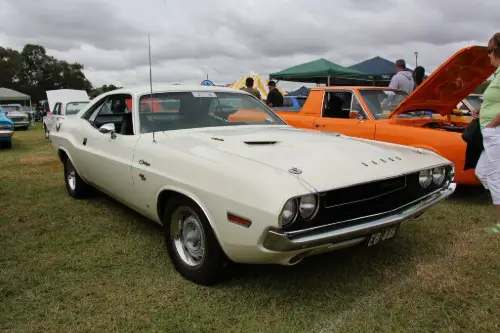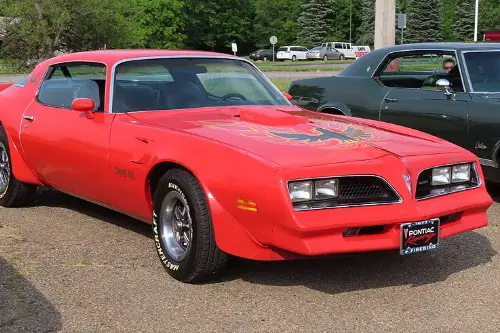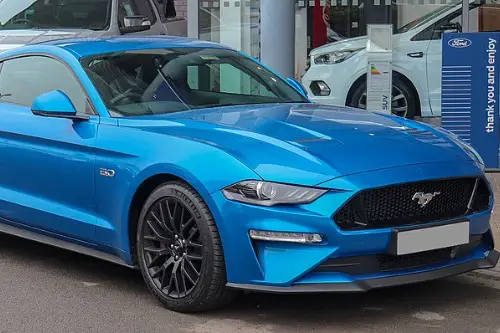1. 1964½ Ford Mustang

When the Mustang debuted in April 1964, it wasn’t just a car—it was a cultural lightning bolt, according to Jim Smart from MotorTrend. Ford expected to sell around 100,000 units in the first year; they hit that in three months and ended up with over 400,000 by the end of 1964. It was affordable, sporty, and looked like a million bucks without costing it. The Mustang practically invented the “pony car” segment without even trying.
Its secret sauce was simple: wide appeal and a ton of customization options. You could get a six-cylinder daily driver or a V8 powerhouse. Baby boomers loved it, and Hollywood quickly embraced it too (hello, Bullitt). The Mustang was cool without even having to rev its engine too hard.
2. 1957 Chevrolet Bel Air

The ’57 Chevy Bel Air was never marketed as a muscle car or a performance beast—but it still became one of the most iconic American cars ever, according to Robert Ross from the Robb Report. Its tailfins, chrome trim, and golden badging screamed confidence without being obnoxious. It looked like the future and nostalgia at the same time, which is no easy trick. And while it was popular in its day, it became a legend after it left production.
Car shows and collectors still obsess over these. It wasn’t the fastest or flashiest by modern standards, but it was effortlessly stylish. Everyone from hot-rodders to prom kings wanted one. It earned its icon status just by showing up.
3. 1992 Jeep Grand Cherokee (ZJ)

This one literally made an entrance—by smashing through a glass window at the 1992 Detroit Auto Show. Jeep’s Grand Cherokee was more than a marketing stunt though; it redefined what an SUV could be. It had the off-road cred of the Cherokee but with real comfort and luxury baked in. And it helped spark the modern SUV boom almost by accident.
Families who didn’t want a minivan suddenly had an option that looked cool and felt tough. It came with a straight-six or a V8, could tackle trails, and still drop kids off at school. Its success wasn’t flashy, but it reshaped the market. Jeep didn’t reinvent the wheel—they just made it a lot more desirable.
4. 1984 Chevrolet Corvette (C4)

The C4 Corvette wasn’t flashy at first glance, but it brought the ‘Vette into the modern age almost overnight, according to Brian Brennan from MotorTrend. With its digital dash, futuristic styling, and tuned-port injection, it felt more like a spaceship than a sports car. GM focused on handling this time around, and it paid off—this Corvette could actually corner. It wasn’t trying to be a legend, it just quietly became one.
It also brought back respect to the Corvette badge after the ‘70s malaise era. People who had written off American sports cars took notice again. It was the right car at the right time, even if it didn’t scream about it. Low-key cool wins every time.
5. 1970 Dodge Challenger R/T

The Challenger R/T showed up late to the pony car party, but it didn’t care—it brought HEMI power and menacing good looks. With options like the 426 HEMI and the 440 Six Pack, it had brute force under the hood. It was big, bad, and unapologetic about being loud and fast. And somehow, it still looked classy doing it, according to Ciprian Florea from Autoevolution.
It didn’t last long in its original run—only until 1974—but its impact lingered. The name came back decades later because people never stopped loving it. Mopar fans treated it like a sacred artifact. This car didn’t ask for legend status, it was born with it.
6. 1969 Chevrolet Camaro Z/28

Chevy didn’t build the Z/28 for mainstream appeal—it was meant to win on the track. Created to dominate the SCCA Trans-Am series, it packed a high-revving 302 V8 and cornered like no other muscle car of the era. No flashy big block, just pure precision and balance. Yet somehow, it became a street icon anyway, Ciprian Florea from Autoevolution explains.
It didn’t even have an automatic transmission option—you had to drive it right. That exclusivity made it even cooler to enthusiasts. It wasn’t trying to be your buddy; it was trying to win. And in doing so, it earned a spot in muscle car mythology.
7. 1991 GMC Syclone

The GMC Syclone came out of nowhere and absolutely stunned the automotive world. It looked like a regular compact pickup, but under the hood, it had a turbocharged 4.3-liter V6 with all-wheel drive. In 1991, it could go 0–60 in about 4.3 seconds—faster than a Ferrari 348 at the time. GMC didn’t brag about it much, but enthusiasts immediately knew this was something special.
Only about 3,000 were made, making it rare right out of the gate. It wasn’t lifted or loud, but it packed insane performance into a plain black wrapper. The Syclone didn’t care about utility or off-road chops—it was a sports car disguised as a truck. It didn’t try to be a legend, it just smoked everything at the stoplight and disappeared.
8. 1977 Pontiac Trans Am (Smokey and the Bandit edition)

All it took was Burt Reynolds, a cowboy hat, and a black-and-gold Trans Am to burn this car into pop culture. The 1977 Trans Am was already a beast, but after Smokey and the Bandit hit theaters, it became legend. Pontiac didn’t change the formula—they just added a shaker hood and some decals. The result? Instant icon.
It didn’t need a 500-horsepower engine to win hearts—it had attitude for days. Sales shot up thanks to the movie, but it was more than a marketing win. It represented a time when American cars were fun, loud, and full of swagger. And it looked good doing absolutely nothing but sliding sideways.
9. 2002 Cadillac Escalade

Let’s be real—no one thought Cadillac would reinvent itself with a giant luxury SUV. But the Escalade hit the early 2000s like a champagne-soaked sledgehammer. It was bold, brash, and draped in chrome, and hip-hop culture grabbed it immediately. It became the car of choice for celebrities, athletes, and anyone who wanted to be seen.
It wasn’t just the bling—it had a serious V8 under the hood and tech that justified the price tag. Cadillac leaned into excess, and somehow it worked. Escalade didn’t need to prove it was cool—it was cool. It rolled up like a legend before it even got broken in.
10. 1966 Ford Bronco

Originally built to compete with the Jeep CJ, the Bronco started off as a practical off-roader. But its simple design, short wheelbase, and go-anywhere spirit made it an instant hit. It didn’t need to scream capability—it just quietly climbed mountains and forded streams. Over time, that rugged charm turned into collector gold.
What really cemented its status was its timeless design. It wasn’t overdesigned or overloaded with features—it just worked. That authenticity kept people talking for decades. And when Ford brought it back in 2021, the hype proved it was never forgotten.
11. 1987 Buick GNX

The GNX was the black sheep of Buick’s lineup—in the coolest way possible. In an era of sluggish cars, the GNX showed up with a turbocharged V6 that could outrun Corvettes. Only 547 were made, and they were all black, all business. It looked like a sleeper, but it was a rocket in disguise.
This wasn’t a car that screamed muscle—it whispered “catch me if you can.” Buick didn’t build it for mass appeal, but that just made it more special. The GNX became a cult classic without even aiming for the spotlight. It was power in a pinstripe suit.
12. 2015 Dodge Hellcat

Nobody expected Dodge—of all brands—to drop a 707-horsepower missile into a family-sized sedan. The Hellcat was absurd in the best way possible. It looked like a regular Charger or Challenger until you heard the supercharger scream. Dodge didn’t ask permission, and the world loved it.
People couldn’t believe a car this fast was also street legal. It smoked Ferraris on the drag strip and still had cupholders. Dodge didn’t set out to make a legend—they just wanted to blow everyone’s minds. And mission very much accomplished.
13. 2005 Ford GT

Ford built the GT as a tribute to their 1966 Le Mans victory over Ferrari. But it wasn’t just retro worship—it was a serious supercar. Mid-engine, aluminum body, supercharged V8—this thing could hang with the best Europe had to offer. And it looked absolutely stunning doing it.
Ford didn’t build many, and they didn’t need to. It was more than a performance machine—it was a love letter to racing history. Everyone from collectors to track junkies fell in love. It became a legend not by chasing glory, but by honoring it.


